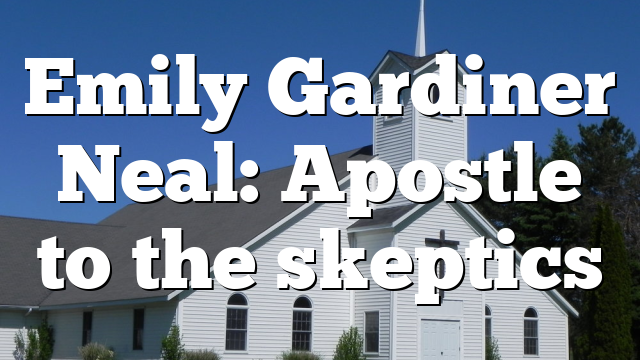Click to join the conversation with over 500,000 Pentecostal believers and scholars
Click to get our FREE MOBILE APP and stay connected
| PentecostalTheology.com



Mrs. Emily Gardner Neal (1911- 1989) is now mostly forgotten despite being a major figure in the healing movement from 1956 when her first book came out, A Reporter Finds God Through Spiritual Healing.[1] Before her conversion she was one of the outstanding reporters of her era. As a Christian her ministry especially impacted Episcopalians by way of her books, innumerable healing missions thru the OSL or independent church events. [2] She was a special resource to the inquiring skeptics of the era, as her story of conversion was of a person raised as an atheist, and who came to Christ only after confronting and testing the evidence of spiritual healing. By the time she went to her eternal reward, she was recognized as one of the most influential woman of her generation, listed in Who’s Who of American Women, The Royal Blue Book (London), and other such sources.
Emily Gardiner Neal was born in 1911 to a well-to-do family and reared in New York City. She was educated at Brearley School for Girls, a private high school for girls in New York City and the David Mannes College of Music, also in New York. She intended to become a concert violinist. Emily’ parents were openly atheistic, and what Emily knew of Christianity was from hearsay. In 1930 Emily married a Navel Academy graduate, Alvin Neal. He too was an atheist. Emily later related that during their courtship they spent many hours talking about the possibility of God’ existence – a sign of their religious longings.
After his required time in the peace-time Navy of the 1930’s, Alvin became a businessman and moved his family to Argentina and later the Netherland West Indies. But before the beginning of World War II the family returned to the United States and settled in Pittsburg. At the outbreak of the War, Alvin reentered the Navy and served as an officer abord the aircraft Carrier USS Ranger.
Emily in the meantime took up journalism. She began her writing career by doing a bi-weekly newspaper column, “Winning the Peace,” dealing with international affairs. She had great connections and sources for her column, her father was the military expert and reporter for the New York Times. She became quite good at the craft of journalism. After the War she specialized in covering current developments in science and medicine with her articles appearing in many of the major magazines such as Look, Redbook, McCalls, and Reader’s Digest, etc. Alvin returned to civilian life serving as an executive with Gulf Oil corporation.
How she became a Christian and an anointed minister of healing prayer is an amazing story of God’s providential choreography. In 1954 her neighbor asked her to drive her to an Episcopal church for a healing service, as her own car was in repair. Emily did the favor and stayed for the service. What she saw utterly amazed her, there seemed to be several instant healings, including a large goiter disappear. In spite of what she had seen, Emily suspected some sort of fraud in the healing service and determined to carefully examine the issue of spiritual healing with all of the reporting and critical skills she had developed. Her objective was to expose as fraudulent the healing claims being made by Christian healing ministers of the era. It ended as being the story of her own conversion and the true effectiveness of Christian healing prayer.
Mrs. Gardiner Neal interviewed scores of patients with their permission, and with her reporter’s credentials, was able to access patients’ medical records, documenting initial diagnosis, and well as after-healing reports. She was doing what William James had urged back in the 1900s in his famous book Varieties of Religious Experiences.[3] That is, when you have a questionable spiritual claim or experience, collect as many examples of the said phenomenon as possible before coming to conclusions. The doctors of the period, as well as many academicians, did the opposite. Their methodology was to affirm their materialist philosophy disregard real case studies, and declare miraculous healing impossible because “modern science” proved that miracles were mythical and not real.[4] She found that time after time, after presenting the doctors with the evidence of their own patient’s miraculous healing, they would attribute the recover to some cause other than prayer, usually “mistaken diagnosis.” For example, she cited one case of a man with lung cancer:
The diagnosis had been based on an extensive series of X rays, bronchoscopy, and sputum tests – all positive. As a result, the patient scheduled for resection of five ribs and removal of the affected lung.
Shortly before the operation was to be performed, the patient attended a healing service and claimed a cure. When returned to the hospital for final examination prior to surgery, a repetition of the previously conducted tests revealed no evidence of lung cancer. He was dismissed from the hospital, and is today in robust health. The medical explanation was, again, mistaken diagnosis.[5]
On one occasion Alvin accompanied Emily on an interview of a patient cured of cancer. Emily related what happened in the car after the interview:
“I heard Alvin clear his throat and say: “You know, there may be something to this work you’re doing, after all. Did You notice the radiance—the strange luminosity of that man’s face? I don’t know how to explain what I felt in him. All I’m sure of is that that man been touched by something I don’t know anything about.[6]
Alvin came to fully support her healing ministry.
Emily’s book, A Reporter Finds God and should be considered among the top dozen works in the literature of Christian healing. Her concern for the skeptically minded of her day was manifested in her careful attention to the data of documented healings and her methodical procedures. In several other of her books, she also took aim at skepticism towards the supernatural and healing miracles. Her story of leaving skepticism behind would be an eye opener to today’s generation of skeptics.[7] (Hint: it would make an excellent gift to a skeptical/agnostic relative or friend – readily available at used book sites).
A Reporter Finds God was immensely successful, it was reprinted at least 15 times by 1965. After its launch Emily decided to learn more about Christianity, not just the healing ministry. She entered seminary and completed a degree in theology. Mrs. Neal then attended the Pittsburgh Pastoral Institute and was permitted to take courses open only to clergy, such as pastoral counseling. In fact, she became an effective and active Christian counselor for the rest of her life.
Dr. Alfred Price, Rector of St. Stephen’s Church (see chapter 18 above) noticed the success of A Reporter Finds God and, asked Mrs. Neal to speak at the annual St Stephen’s conference for the Fall of 1956. Her presentation was a great success. Teaching also at this conference were Agnes Sanford and Ethel Bank. Here Mrs. Neal was introduced into the intertwined world of the OSL and the CFO, which she would cultivate for the rest of her life.
Shortly afterward, Mrs. Neal was invited to her first healing mission in Wisconsin. There she was asked to participate in the laying on of hands. It was the first time for her. Her respect for the Church’s authority prompted her to phone Bishop Pardue, her bishop in Philadelphia, to ask what to do – he gave her permission to do so, and this began her personal healing ministry.
In 1957 the editor of Prentice Hall asked her to write her second book, and the result was God Can Heal You Now, which came out in 1958.[8] Mrs. Neal’s orthodoxy and healing anointing was widely recognized and requests to speak and to lead healing missions poured in. This served to distance her from her career as a successful magazine writer. She tried to resist the pull away from being a reporter, which she enjoyed doing, and had done so well. But the love of the Lord drew her to His work. The Lord Is Our Healer [9] was published in 1961 and her recognition as an outstanding author and speaker of the healing ministry continued to grow.
With three bishops, three priests, and two physicians she served on the Joint Commission on the Ministry of Healing appointed at the 1961 General Convention of the Episcopal Church to study the Church’s ministry of healing. The Commission’s report, which strongly affirmed the reality and need of the Church’s healing mission, was submitted to the General Convention of 1964, was unanimously approved by both the House of Bishops and the House of Deputies. This proved to be a boost to the prestige and acceptability of the healing ministry among Episcopal clergymen. Of course, the report was no guarantee that the liberal-Sadducaic clergymen, of which there were many in the Episcopal Church, would accept or act upon the report. As it turned out, the Episcopal Church continued to be a denomination where many of its churches had no healing ministry at all and mostly continued on their journey to destructive liberal theologies.
In 1966 she was asked by The Rev. Dr. John Baiz to lead weekly healing services and counsel at Calvary Church in Pittsburgh. This she did for ten years, along with traveling widely on missions throughout the United States and abroad and continuing to write books about healing prayer. Mrs. Gardiner Neal’s theology has many parallels with the that of Mrs. Agnes Sanford, and much influenced by her work. For instance, Emily practiced inner healing prayer in her counseling ministry. Mrs. Gardiner Neal also followed Mrs. Sanford in appreciating the value of sacramental confession in healing. Also like Mrs. Sanford, Mrs. Gardiner Neal welcomed the charismatic renewal and its boost to the healing ministry, but like her mentor expressed reservations about its sometimes over-exuberant manifestations.[10]
The works of these two women overlapped and might be classed among the first generation of orthodox Christian works on healing that were readily available to the public. True, the whole generation Anglican/episcopal clergymen and women such as Pearcy Dearmer and Ethel Banks had done great work, as did the multiple Pentecostal healers. But they published in the era before WWII, when most American cities did not have even a single bookstore, and books had to be ordered by mail, thus their works were limited in circulation. But in the post-War era bookstores and the paperback industry exploded and the book of Mrs. Gardiner Neal and Mrs. Sanford were able to reach mass audiences.[11]
Mrs. Gardner Neal moved in 1976 to Cincinnati, where she lived on the grounds of the Convent of the Transfiguration, an Episcopal community of nuns. She was ordained a deacon by Bishop Robert Appleyard in Pittsburgh on January, 1978. In Cincinnati, she served on the staff of St. Thomas Episcopal Church as Deacon, leading weekly healing services and counseling. At the Convent she also functioned as deacon and led a monthly healing service and counseled weekly. In 1987 the Episcopal Healing Ministry Foundation was formed Emily and several of her Episcopal friends to specifically carry out the work of training and equipping Episcopalians in the healing ministry, and served as its president until her death on September 23, 1989.
[1] Emily Gardner Neal, A Reporter Finds God Through Spiritual Healing (New York Morehouse-Barlow,1956). To date there has been no book length boioraphy of Mrs. Gardiner Neal. I have depended for biographical information on two sources, Ann[e] sassel’s brief article in Sharing, “Emily Gardiner Neil’s Story,” (Dec. 1989) 18-22, and the biographical fact sheet foune at the archives of Wheaton College, “Emily Gardiner Neal.” https://archives.wheaton.edu/aqents/peopleZ2708 Sourced 1/102024.
[2] Mrs. Neal’s numerous books are readily available on Amazon and on online used book sites such as abebooks.com. A very useful anthology of her Christian writings is Emily Gardiner Neal, Anne Cassel, ed. The Reluctant Healer: One Woman;’ Journey of Faith (Colorado Springs: Shaw, 1992
[3] William James, Varieties of Religious Experiences (New York: Modern Library, 1902).
[4] See my discussion of this my m work, Agnes Sanford and Her Companions. Chapter 23.
[5] Neal, A Reporter, 37.
[6] Emily Gardiner Neal, In the Midst of Life (New York: Hawthorn, 1963). 23.
[7] See for instance “Forward to a skeptic,” in: Emily Gadiner Neal, Where There is Smoke; The Mystery of Christian Healing (NY: Morehouse-Barlow, 1967) 5-14.
[8] Emily Gardner Neal, God Can Heal You Now (Englewood-Cliffs: Prentice-Hall, 1958).
[9] Emily Gardner Neal, The Lord is Our Healer (Englewood Cliffs: Prentice-Hall, 1961).
[10] Neal, Our Healer, 39
[11] WWII changed that through the massive publication of quality books as cheap paperbacks for the GI’s and created a large reading public. Applebaum, Yoni. ‘’Publishers Gave Away I 22.951,031 Books During World War II” The Atlantic, September 10, 2014.




Most Talked About Today